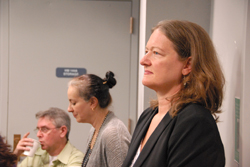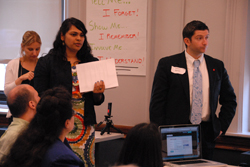Filed Under > NYC Schools
Getting Inclusive
As New York City improves its track record in accommodating students with disabilities, score a major assist for TC
By Joe Levine
New York State has been a leader in many areas of public school education – but meeting the needs of students with disabilities has not been one of them. New York ranks 51st in the United States (including D.C., Guam, and Puerto Rico) in providing students with disabilities access to general education curriculum and classrooms as mandated under the 1997 Individuals with Disabilities Act (IDEA).
The good news is that New York City, for its part, is making a concerted effort to change that picture. Two years ago, the city hired Laura Rodriguez, a veteran administrator and former Bronx teacher, as the first Deputy Chancellor in charge of its new Division of Students with Disabilities and English Language Learners. The city’s Department of Education also announced a major initiative to hold schools accountable for meeting students’ special education needs, give them more flexibility in providing special education services, and foster greater collaboration with parents.
In February 2010, Rodriguez created a strategic partnership with Teachers College’s Inclusive Classrooms Project (TCICP), which supports research, teaching and service to create organizational structures and curricular opportunities for students of all abilities. During the past school year, under the co-direction of Celia Oyler, Associate Professor of Education and Britt Hamre, Lecturer in Curriculum & Teaching, TCICP has brought together “spotlight instructional practices inquiry to action” teams of city teachers (facilitated, in several instances, by TC faculty members) to create professional development for their colleagues across a range of areas.
And in early June, over 500 teachers, principals and paraprofessionals from schools across the city gathered at the College for “Expanding Mindsets, Transforming Practices,” a full-day of professional development workshops led by the spotlight action teams.
“There are hundreds of thousands of teachers in New York City with extraordinary knowledge and skills in teaching students of all levels,” Oyler told the audience in her opening address. “Research documents the power of grassroots, teacher-to-teacher learning, so our idea is to unleash the talents of the teachers who do this day by day.”
Rodriguez, who followed Oyler to the podium, said her work is really about educating all children.
“There’s a lot to learn, and a lot we don’t know in the 21st century,” she said, pinpointing technology as an especially fertile area for improvement – and one in which there is a particularly wide gap between students and their teachers. “We’re in an ever-evolving, technologically sophisticated society, within a global context where children get interested in things adults don’t understand because we don’t have access to the same information they do. Assistive technologies will help all students, add a new dimension of support and make all our jobs easier.”
Rodriguez said her three main goals are:
- to build new capacity within the city’s Department of Education leadership team, “starting with me – I realize I have a lot of learning to do every day”; at the “network level” of cooperating groups of schools; and at the individual school level, as well;
- to close the “huge achievement gap” between general education students and students with disabilities – a gulf that in many instances mirrors the gap between poorer, minority students and their wealthier and typically white counterparts;
- and to ensure appropriate use of the Individualized Education Plan (IEP), the document created to provide the best services to each student with disability.
“The IEP is both a legal document and a dynamic instructional tool that’s meant to be routinely touched and integrated into the instructional process,” Rodriguez said. “It integrates each school professional, as well as the parent and the child, as a valued member of the team. We’re hearing from too many college students that it’s only now, at college, that they’re beginning to understand their own IEPs, and that’s too late. The continuum of services allows more latitude than we’ve given ourselves in New York City, and the IEP is really about promoting that more flexible instructional program.”
Shael Polakow-Suransky, the city’s Chief Academic Officer, added that when children with disabilities feel safe and accommodated in school, it becomes possible for them to “become eloquent and reflective about their needs and strengths and to shape the understanding of others about what means to have a disability and how to manage it.” He said that the city is engaged in an effort right now to tie both curriculum and assessment more closely to the new Common Core Standards that New York and most other states have embraced, and that by integrating Universal Design for Learning “special education is at the center of this reform and not off to the side.”
The rest of the day was devoted to presentations by teachers from all of the spotlight action teams and breakout professional development workshops in each of their areas.
At a break-out session called “Assistive Learning Technologies: Speed Dating,” about 50 educators did a whirlwind tour of demonstrations by Department of Education teachers demonstrating various technologies, ranging from the fancy to the pedestrian, which help all students learn.
On the high-tech end, they learned about educational applications for the iPad, such as an application that reads a downloaded web page out loud, and another that streams lessons from the web. At the next station over, Bruce Freifeld, an assistive technology evaluator for the DOE, demonstrated the Neo2 portable word processor, which helps students with motor difficulties learn how to type, write and spell with a minimum of keyboard strokes.
“It’s astonishing how self-motivating it is,” Freifeld said.
“Beautiful,” pronounced Maria Victoria Cardona, a TC alumna and special education teacher at P.S. 23 in the Bronx. “There’s no way to get lost.” She said much of the technology she was seeing would allow students to “overcome their disability, but not to live in the disability.”
At a table called “Dance With the One You Brought,” conference goers were reminded of things they already have in their classrooms that can help adapt lessons for disabled learners, including a three-ring binder that can put a slant beneath any reading material, and a file folder with a horizontal window cut out of it and colored cellophane taped over the window to reveal a few lines of type at a time, which helps those with certain print disabilities to learn to read.
Ann Anesta, an instructional specialist for school improvement with the New York City Department of Education, smiled approvingly at the cellophane technique, which had a fancy name – “tachistoscope” – but which teachers have been using since she started in the classroom 30 years ago. “What’s old is new again,” she said.
Anesta said TC’s partnership with the DOE was “fabulous – very commendable,” for training new teachers how to use the best technology. For too long, she said, disabled children were placed in self-contained classrooms. Now they are benefitting from being included in the general education classroom, with or without the aid of new technology. Educators have come to understand, she said, that “special ed is not a placement, but a service,” that can be provided to many students with special-needs in a regular classroom.
Yolanda Sealey Ruiz, TC Assistant Professor of English Education, told the audience that culturally responsive pedagogy – the focus of the working group she facilitated – is neither an excuse for teachers to lower expectations nor simply a focus for minority students.
“All people have culture, not just students of color, but those are the students whose culture has historically not been present in the curriculum,” she said. “CRP isn’t something you learn even in an extended series of professional development sessions. It’s a self-reflexive habit of mind and heart that you develop over time. Ultimately, it’s an opportunity for cross-cultural conversation, human understanding, and higher levels of human involvement that improve academic outcomes for all students.”
Lalitha Vasudevan, TC Assistant Professor of Technology and Education, who facilitated a group on learning through multi-modal projects, asked the audience to imagine “a young man in a leather jacket, bounding into class, headphones on, 15 minutes early, pulling out a PSP and a USB cable to a laptop for an I-movie with tracks he composed at home.
“Young people are engaged right now in so many new ways of meaning-making, in ways that are not always readily available in school,” she said. “So can we, as teachers, engage in multi-modal ways of seeing and knowing.” Vasudevan ended by quoting Henry Miller: “The moment one gives close attention to anything, even a blade of grass, it becomes a mysterious, awesome, indescribably magnificent world in itself.”
Published Wednesday, Jul. 6, 2011

